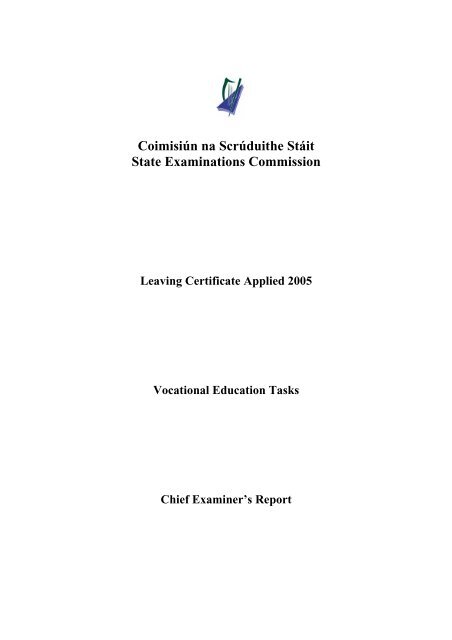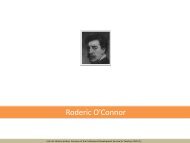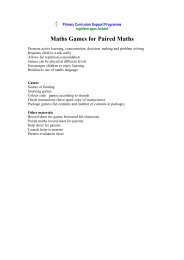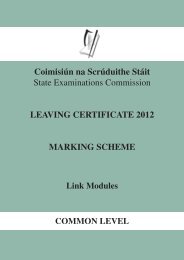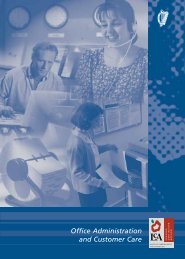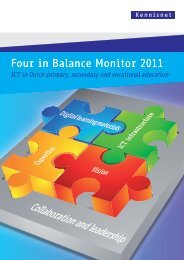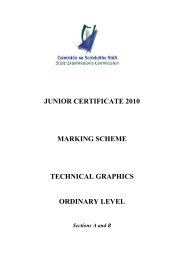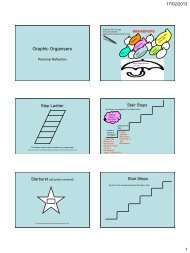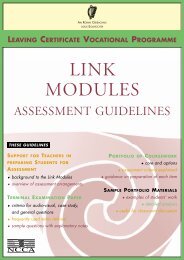Vocational Education Tasks - PDST
Vocational Education Tasks - PDST
Vocational Education Tasks - PDST
You also want an ePaper? Increase the reach of your titles
YUMPU automatically turns print PDFs into web optimized ePapers that Google loves.
Coimisiún na Scrúduithe Stáit<br />
State Examinations Commission<br />
Leaving Certificate Applied 2005<br />
<strong>Vocational</strong> <strong>Education</strong> <strong>Tasks</strong><br />
Chief Examiner’s Report
Contents<br />
1. Introduction .............................................................................................................3<br />
2. Performance of Candidates......................................................................................4<br />
3. Analysis of Candidate Performance ........................................................................5<br />
4. Conclusions ...........................................................................................................12<br />
5. Recommendations .................................................................................................14<br />
Appendix 1: Credit Tables....................................................................................17<br />
Appendix 2: Marking Criteria ...............................................................................28<br />
Appendix 3: Range of <strong>Tasks</strong> .................................................................................34<br />
2
1. Introduction<br />
This report gives feedback on the assessment of the Leaving Certificate Applied <strong>Vocational</strong><br />
<strong>Education</strong> <strong>Tasks</strong> for the years 2002-2005. It was compiled from the reports submitted by examiners<br />
to the State Examinations Commission and from an analysis of candidates’ results carried out by the<br />
Chief Examiner.<br />
The <strong>Vocational</strong> <strong>Education</strong> <strong>Tasks</strong> comprise ten per cent of the total assessment for the Leaving<br />
Certificate Applied programme, as follows:<br />
Assessment framework for the Leaving Certificate Applied programme<br />
Programme element<br />
Leaving Certificate Applied programme 200<br />
maximum number of credits<br />
<strong>Tasks</strong> (7) 70 (7×10)<br />
<strong>Vocational</strong> <strong>Education</strong> <strong>Tasks</strong><br />
These are based on the two vocational specialisms<br />
chosen by candidates from the following:<br />
1. Active Leisure Studies<br />
2. Agriculture/Horticulture<br />
3. Childcare/Community Care<br />
4. Craft and Design<br />
5. Engineering<br />
6. Graphics and Construction Studies<br />
7. Hair and Beauty<br />
8. Hotel, Catering and Tourism<br />
9. Information and Communication Technology<br />
10. Office Administration and Customer Care<br />
11. Technology<br />
20 (2×10)<br />
The chart shows the percentage of Leaving Certificate Applied candidates presenting tasks in the<br />
different vocational specialisms in year 1 and in year 2 for the 2005 assessment. The distribution is<br />
similar for the other years. Typically the Hotel, Catering and Tourism specialism is very popular<br />
for year 1 candidates and the Information and Communication Technology is very popular for year<br />
2 candidates.<br />
35<br />
30<br />
% LCA candidates<br />
25<br />
20<br />
15<br />
10<br />
5<br />
year 1<br />
year 2<br />
0<br />
1 2 3 4 5 6 7 8 9 10 11<br />
<strong>Vocational</strong> specialism<br />
3
2. Performance of Candidates<br />
Appendix 1 contains eleven tables showing the number of credits awarded to candidates in the<br />
different <strong>Vocational</strong> <strong>Education</strong> <strong>Tasks</strong> for year 1 (session 2) and year 2 (session 3) candidates in the<br />
years 2002-2005.<br />
The last column in each table represents the total number of Leaving Certificate Applied candidates<br />
assessed in the session. The second last column in each table expresses the number of candidates<br />
presenting a task in a specialism as a percentage of the total candidature.<br />
4
3. Analysis of Candidate Performance<br />
3.1 Timing of assessment<br />
Candidates complete their first <strong>Vocational</strong> <strong>Education</strong> Task in year 1(session 2) and their second in<br />
year 2 (session 3). Assessment of the <strong>Vocational</strong> <strong>Education</strong> <strong>Tasks</strong> is based on authentic evidence of<br />
task completion together with a task report and an interview. The recommended time for<br />
completing a task is ten hours.<br />
The tasks are assessed by external examiners in early May for year 1 candidates and in early<br />
February for year 2 candidates. The external examiners are appointed and trained by the State<br />
Examinations Commission.<br />
3.2 Assessment criteria<br />
<strong>Vocational</strong> education tasks are assessed using the following criteria<br />
• ability of a candidate to select and plan effectively a <strong>Vocational</strong> <strong>Education</strong> Task<br />
• quality of engagement by the candidate in the activity and evidence provided of progress<br />
and achievement<br />
• ability of a candidate to reflect upon and evaluate the experience of undertaking and<br />
completing the <strong>Vocational</strong> <strong>Education</strong> Task<br />
• quality of integration and learning by the candidate<br />
• evidence of cross-curricular applications<br />
• quality of communicative ability.<br />
The detailed indicators for these criteria are listed in appendix 2.<br />
Good practice<br />
Examiners found that the assessment process for <strong>Vocational</strong> <strong>Education</strong> <strong>Tasks</strong> worked best when<br />
• schools and centres provided the examiner with suitable accommodation, relevant equipment<br />
and a running order of candidates for assessment<br />
• examiners had an opportunity to meet the group of candidates briefly before carrying out the<br />
assessment of the tasks<br />
• the tasks were clearly labelled, collated and available to examiners on arrival, so that examiners<br />
could examine the <strong>Vocational</strong> <strong>Education</strong> <strong>Tasks</strong> prior to, and in preparation for, the interviews<br />
with candidates<br />
• candidates were well prepared and understood their role in the assessment process<br />
• candidates were at ease with the interview component and were available for interview when<br />
required.<br />
Areas for development<br />
In a small number of cases, tasks were not available when the examiner arrived in the school and<br />
considerable time was wasted in locating these tasks. This practice was regarded as most<br />
unsatisfactory by examiners.<br />
Examiners reported that some candidates were still working on their task on the day of assessment.<br />
In such cases, examiners reported an unsatisfactory delay in receiving these tasks for assessment.<br />
To minimise unnecessary delays, examiners have requested that candidates do not present their task<br />
reports in binders containing plastic covers for individual pages. This causes difficulties for<br />
examiners who must check every page for material relevant to the task and officially stamp all<br />
reports presented.<br />
5
3.3 Purpose of <strong>Vocational</strong> <strong>Education</strong> <strong>Tasks</strong><br />
A <strong>Vocational</strong> <strong>Education</strong> Task is a practical activity through which students integrate and apply<br />
learning experiences gained from the Leaving Certificate Applied programme. A task may involve<br />
• developing a product<br />
• investigating an issue<br />
• performing an action<br />
• providing a service<br />
• staging an event<br />
• personal reflection on an aspect of learning in the vocational specialism.<br />
The tasks provide an opportunity for students to<br />
• integrate learning and practical experiences from the different courses and modules of the<br />
programme<br />
• develop literacy, communication and numeracy skills<br />
• develop confidence and self-esteem<br />
• develop responsibility and initiative as well as skills in self-evaluation, problem solving,<br />
reflection and management<br />
• apply to practical problems and issues the knowledge, understanding, skills and competencies<br />
developed through participation in the modules<br />
• develop co-operation and team work.<br />
Good practice<br />
Examiners were generally satisfied that the majority of candidates had presented tasks that were<br />
relevant and appropriate to the vocational specialism they had undertaken.<br />
The majority of candidates demonstrated a high level of enthusiasm and commitment in the<br />
preparation and presentation of the tasks. This was particularly evident where candidates selected<br />
their own tasks.<br />
Areas for development<br />
Examiners expressed concern that some tasks were not entirely relevant to the vocational specialism<br />
being assessed.<br />
3.4 Promoting cross-curricular applications and integration through the <strong>Vocational</strong><br />
<strong>Education</strong> <strong>Tasks</strong><br />
Cross-curricular application is intended to link the learning from the vocational education element<br />
and other elements of the Leaving Certificate Applied programme and is seen as a very important<br />
aspect of the <strong>Vocational</strong> <strong>Education</strong> <strong>Tasks</strong>. By integrating learning in this way, the tasks help to<br />
make students aware of links between the concepts, skills, competencies, experiences, knowledge<br />
and understanding that they have developed through the whole Leaving Certificate Applied<br />
programme.<br />
Mathematical Applications and Information and Communication Technology (ICT) are mandatory<br />
areas of cross-curricular applications in the <strong>Vocational</strong> <strong>Education</strong> <strong>Tasks</strong>. Where students undertake<br />
tasks in ICT, they are required to show evidence of cross-curricular applications from Mathematical<br />
Applications and at least one other Leaving Certificate Applied course.<br />
6
Good practice<br />
Examiners noted that candidates who performed well in the tasks showed evidence of relevant<br />
cross-curricular applications, in addition to the mandatory areas.<br />
Areas for development<br />
Cross-curricular applications and integration continue, in many instances, to be contrived rather<br />
than substantive. This results in low scoring for candidates in this criterion. Many candidates did<br />
not achieve effective and meaningful integration in the mandatory area of Mathematical<br />
Applications.<br />
3.5 Balance between teacher support and student autonomy<br />
Students following the Leaving Certificate Applied programme should be actively involved in the<br />
identification, design and planning of their <strong>Vocational</strong> <strong>Education</strong> <strong>Tasks</strong>. Students have the main<br />
responsibility for the task and it must their own work. The teacher may, however, need to advise<br />
and guide students in<br />
• identifying appropriate and relevant topics<br />
• setting manageable and clear objectives<br />
• planning and managing a time schedule to complete the <strong>Vocational</strong> <strong>Education</strong> Task<br />
• developing research skills<br />
• identifying potential human and material resources<br />
• identifying other courses that might help in a meaningful way<br />
• developing and encouraging integration<br />
• examining and identifying areas of strengths and<br />
• developing language and communication skills<br />
weaknesses<br />
• understanding the assessment requirements of the <strong>Vocational</strong> <strong>Education</strong> Task<br />
• learning the technical skills required to make a presentation.<br />
Good practice<br />
Examiners reported that the best tasks were those where an appropriate balance was struck between<br />
teacher guidance and the individual responsibility of the candidate.<br />
Areas for development<br />
Examiners reported that where a teacher input was excessive, it resulted in uniformity of tasks, lack<br />
of individual candidate contribution and engagement, lack of understanding of the aims and purpose<br />
of the task and poor performance at interview.<br />
In product-type tasks in particular, some teachers provided candidates with specific design briefs<br />
which limited candidates’ creativity and initiative.<br />
Some investigation-type tasks lacked originality and were, in the view of the examiners, excessively<br />
teacher-led. In such cases, many candidates failed to analyse findings, reach conclusions and<br />
integrate learning in their investigations.<br />
7
3.6 Group tasks<br />
The <strong>Vocational</strong> <strong>Education</strong> <strong>Tasks</strong> may be undertaken on a group basis. The number of students<br />
involved in a group should be kept to a minimum. Each student in a group task should have a<br />
clearly-defined individual role, which allows each student to make a meaningful contribution to the<br />
group task. It should take each individual student at least ten hours to complete a <strong>Vocational</strong><br />
<strong>Education</strong> Task. It is important that the individual student presents an overall description of the<br />
group task and has a clear understanding of the nature and objectives of the whole task while at the<br />
same time presenting a report on their individual contribution to the group task.<br />
Good practice<br />
Candidates who presented individual tasks, or who had been assigned specific roles within group<br />
tasks, fared better in the assessment than candidates who participated in group task without a clearly<br />
defined role.<br />
Group tasks were most successful when each candidate had an appreciation of the nature and<br />
objectives of the whole task, together with a clear understanding of their own role. This was<br />
reflected in the candidate’s task report which outlined an overall description of the group task but<br />
remained focused on their own individual contribution to that task.<br />
Areas for development<br />
In some instances, group tasks were not substantial enough to support an adequate work<br />
involvement for each of the participants. Examiners also found that the number of participants in<br />
some group tasks was too large.<br />
The failure of many group tasks to address the area of individual candidate contribution continues<br />
to be a problem. In some cases, candidates did not fully document their own contribution to such<br />
tasks. Examiners expressed concern that although candidates involved in group tasks generally<br />
presented individual task reports, they often included large amounts of copied material related to the<br />
contribution of other participants in the group.<br />
In some cases where a product was presented as part of a group task, examiners had great difficulty<br />
in identifying and crediting the individual contribution and involvement of each candidate.<br />
3.7 Evidence of task completion<br />
Depending on the nature of the <strong>Vocational</strong> <strong>Education</strong> Task, authentic evidence of task completion<br />
by the candidate may be in the form of a finished product/artefact, a record/log/portfolio, which<br />
may include supporting photographic and/or video evidence of the investigation, event,<br />
performance or service undertaken. Authenticity is verified by the school authorities by completing<br />
the Sate Examinations Commission’s Foirm P2.<br />
Good practice<br />
When candidates used a diary/logbook to record the progress of their work on the tasks, it helped to<br />
provide a focus and order in task preparation.<br />
8
3.8 Task report<br />
A task report is a description of the various stages required to complete a <strong>Vocational</strong> <strong>Education</strong><br />
Task. A task report should include the following information<br />
• title<br />
• statement of the aims<br />
• plan of action<br />
• an account of the steps taken in carrying out the task<br />
• presentation and analysis of findings<br />
• evaluation of the task and the candidate’s own contribution<br />
• how other courses contributed to the <strong>Vocational</strong> <strong>Education</strong> Task.<br />
Students may incorporate evidence of investigation and any other support documents into their final<br />
report.<br />
Good practice<br />
Good task reports displayed clear aims, good planning and remained focussed throughout. Such<br />
reports were concise and well presented.<br />
Good research skills were evident in cases where candidates used a variety of appropriate<br />
information-gathering techniques and a discriminating approach in the selection of material relevant<br />
to their task.<br />
The layout and organisation of some task reports were excellent. It was evident that candidates<br />
structured their task reports around the headings of the task assessment criteria.<br />
The best written reports included a table of contents, well organised content and evidence of<br />
relevant research, planning or investigation undertaken, e.g. copies of correspondence sent and<br />
received, relevant photographic evidence, copies of questionnaires, record of interviews,<br />
bibliography.<br />
Examiners were impressed by the effective use of Information and Communication Technology<br />
(ICT) in task report preparation and presentation.<br />
Candidates who presented videotape evidence to illustrate specific aspects of their tasks generally<br />
fared well in the assessment.<br />
In most cases where products/artefacts were produced, health and safety considerations were<br />
evident in the planning process.<br />
Areas for development<br />
Some candidates did not include appropriate evidence of the research methods used in their task.<br />
For example, candidates reported the use of methodologies such as interviews and questionnaires<br />
but failed to provide any evidence. Sources of information including books and web sites were<br />
frequently not credited.<br />
Over-reliance on photocopied materials, transcription and indiscriminate use of information<br />
downloaded from the Internet seemed to undermine the educational aims of the <strong>Vocational</strong><br />
<strong>Education</strong> Task.<br />
Candidates continue to have difficulty in the area of self-evaluation and product evaluation.<br />
9
Examiners have expressed concern about the choice of investigations as opposed to products in<br />
some specialisms. They feel that weaker candidates in particular can achieve higher scores when<br />
they are involved in a product-type task. In such cases candidates also find it easier to evaluate<br />
products.<br />
3.9 The interview<br />
The interview involves a discussion between the examiner and a candidate on the work involved in<br />
the task. The discussion lasts for at least five minutes of the twenty minutes allocated to the<br />
assessment of each candidate’s task.<br />
Good practice<br />
It was evident from the interview component that candidates in general had a good knowledge and<br />
understanding of the task they presented.<br />
3.10 Range of tasks presented<br />
The <strong>Vocational</strong> <strong>Education</strong> <strong>Tasks</strong> presented for assessment in session 2 and in session 3 originated<br />
from eleven different specialisms, as follows:<br />
<strong>Vocational</strong> specialisms in the Leaving Certificate Applied programme<br />
1. Active Leisure Studies<br />
2 . Agriculture/Horticulture<br />
3. Childcare/Community Care<br />
4. Craft and Design<br />
5. Engineering<br />
6 . Graphics and Construction Studies<br />
7. Hair and Beauty<br />
8. Hotel, Catering and Tourism<br />
9. Information and Communication Technology<br />
10. Office Administration and Customer Care<br />
11. Technology<br />
The types of tasks included the development of products/artefacts, staging of events, provision of<br />
services and investigation of issues/topics. Appendix 3 includes examples of the range of tasks<br />
presented for the different vocational specialisms.<br />
Good practice<br />
Examiners reported that the majority of candidates demonstrated a very satisfactory level of<br />
practical skills with excellent standards evident in some cases. However, the standard of skills<br />
varied considerably, ranging from very poor in a small number of cases to some tasks that exceeded<br />
the standard as laid down in the guidelines for tasks.<br />
Candidates generally demonstrated a high level of competency in the area of oral communication.<br />
Examiners commented that candidates were comfortable with and confident in their approach to the<br />
interview component of the assessment.<br />
10
Examiners also commented favourably on candidates’ skills in the area of Information and<br />
Communication Technology (ICT). The appropriate and effective application of these skills was<br />
evident in the majority of tasks presented.<br />
Other skills which were commended by examiners included<br />
• manufacture and assembly skills<br />
• manual dexterity in the use of tools and equipment<br />
• computer aided design (CAD) skills<br />
• art and design skills<br />
• photographic and modelling skills.<br />
Areas for development<br />
Some examiners expressed concern that the complexity of tasks undertaken by some candidates and<br />
the high level of skills required in their execution must have demanded more than the ten hours<br />
recommended for task completion. This was the case in many of the product-type tasks presented.<br />
Report-writing skills were generally very satisfactory. However, in some cases the reports which<br />
accompanied products did not match the high quality of the product presented.<br />
Examiners also stated that some reports showed little or no evidence of research and planning or<br />
investigation and that evaluations and cross-curricular applications/integration were often weak.<br />
In summary, examiners reported the following in relation and to the criteria used in <strong>Vocational</strong><br />
<strong>Education</strong> Task assessment:<br />
• candidates’ clarity of purpose has improved in most cases but remains a problem for some<br />
candidates who participate in group tasks<br />
• research and planning could be further improved<br />
• carrying out of task/investigation is generally of a good standard<br />
• analysis of the findings in investigative tasks could be further improved<br />
• self-evaluation and product evaluation are sometimes confused and are weak in many cases<br />
• product evaluation is often omitted for product-type tasks<br />
• the relevance and quality of cross-curricular applications and integration, particularly in the area<br />
of Mathematical Applications needs to be improved in many tasks<br />
• effectiveness of communication and presentation is generally of a high standard.<br />
11
4. Conclusions<br />
• Examiners were generally satisfied that the majority of candidates had presented tasks that were<br />
relevant and appropriate to the vocational specialism they had undertaken.<br />
• The majority of candidates demonstrated a high level of enthusiasm and commitment in the<br />
preparation and presentation of the tasks. This was particularly evident where candidates<br />
selected their own tasks.<br />
• Examiners expressed concern that some tasks were not entirely relevant to the vocational<br />
specialism being assessed.<br />
• Examiners noted that candidates who performed well in the tasks showed evidence of relevant<br />
cross-curricular applications, in addition to the mandatory areas.<br />
• Cross-curricular applications and integration continue, in many instances, to be contrived rather<br />
than substantive. This results in low scoring for candidates in this criterion. Many candidates<br />
did not achieve effective and meaningful integration in the mandatory area of Mathematical<br />
Applications.<br />
• Examiners reported that the best tasks were those where an appropriate balance was struck<br />
between teacher guidance and the individual responsibility of the candidate.<br />
• Examiners reported that where a teacher input was excessive, it resulted in uniformity of tasks,<br />
lack of individual candidate contribution and engagement, lack of understanding of the aims and<br />
purpose of the task and poor performance at interview.<br />
• Group tasks were most successful when each candidate had an appreciation of the nature and<br />
objectives of the whole task, together with a clear understanding of their own role. This was<br />
reflected in the candidate’s task report which outlined an overall description of the group task but<br />
remained focused on their own individual contribution to that task.<br />
• In some instances, group tasks were not substantial enough to support an adequate work<br />
involvement for each of the participants. Examiners also found that the number of participants<br />
in some group tasks was too large.<br />
• In some cases where a product was presented as part of a group task, examiners had great<br />
difficulty in identifying and crediting the individual contribution and involvement of each<br />
candidate.<br />
• The best written reports included a table of contents, well organised content and evidence of<br />
relevant research, planning or investigation undertaken, e.g. copies of correspondence sent and<br />
received, relevant photographic evidence, copies of questionnaires, record of interviews,<br />
bibliography.<br />
• Over-reliance on photocopied materials, transcription and indiscriminate use of information<br />
downloaded from the Internet seemed to undermine the educational aims of the <strong>Vocational</strong><br />
<strong>Education</strong> Task.<br />
12
• Examiners reported that the majority of candidates demonstrated a very satisfactory level of<br />
practical skills with excellent standards evident in some cases. However, the standard of skills<br />
varied considerably, ranging from very poor in a small number of cases to some tasks that<br />
exceeded the standard as laid down in the guidelines for tasks.<br />
• Some examiners expressed concern that the complexity of tasks undertaken by some candidates<br />
and the high level of skills required in their execution must have demanded more than the ten<br />
hours recommended for task completion. This was the case in many of the product-type tasks<br />
presented.<br />
13
5. Recommendations for teachers and students<br />
Arrangements for assessment of <strong>Vocational</strong> <strong>Education</strong> <strong>Tasks</strong><br />
• All material for assessment including products/artefacts should be clearly labelled, collated<br />
and made available to examiners on arrival at a centre. A running order of candidates for<br />
assessment should also be provided.<br />
• Accommodation provided by the school should be appropriate for the assessment process,<br />
i.e. a comfortable and quiet environment.<br />
• Examiners should be made aware of candidates with special needs in advance of the<br />
assessment, particularly if the special needs may have an impact on the interview component<br />
of the assessment e.g. speech and language difficulties etc.<br />
Process of selecting and undertaking tasks<br />
• <strong>Tasks</strong> undertaken by candidates should be relevant to the vocational specialism being<br />
examined and consistent with the time recommended for task completion.<br />
• Opportunities for the meaningful and relevant integration of the mandatory areas of crosscurricular<br />
application should be fully exploited and developed in the <strong>Vocational</strong> <strong>Education</strong><br />
<strong>Tasks</strong>.<br />
• An appropriate balance should be struck between teacher guidance in task selection and<br />
preparation, and the individual responsibility of candidates.<br />
• In group tasks, all candidates should be allocated an adequate and clearly identifiable role to<br />
facilitate appropriate engagement and subsequent awarding of credit for individual<br />
contribution.<br />
• It is essential that each participant in a group task has an appreciation of the nature and<br />
objectives of the whole task, together with a clear understanding of their own role.<br />
• The contribution of each individual candidate to a group product-type task should be clearly<br />
marked for easy identification by the examiner.<br />
• Candidates involved in a group task should present an individual task report focused on their<br />
own contribution only. The use of a diary/logbook to record the nature and progress of an<br />
individual's input to the group task work would help to provide such a focus in task<br />
preparation.<br />
Task reports<br />
• The importance of including relevant evidence and materials to support research, planning<br />
or investigations undertaken should be further emphasised.<br />
• Candidates should be encouraged to be selective about what they include in their task<br />
reports, and should not rely solely on photocopied materials, transcription and the<br />
indiscriminate use of information downloaded from the Internet.<br />
14
• It is recommended that candidates receive further guidance and practice in order to develop<br />
critical skills of reflection and evaluation.<br />
Interview preparation<br />
• The importance of the interview component of the task assessment should be further<br />
emphasised. Candidates should be aware that the interview provides them with an<br />
opportunity to improve their marks for tasks presented. It is therefore recommended that<br />
adequate preparation for the interview be undertaken with candidates in class to enable them<br />
to maximise their performance in this important component of the assessment.<br />
15
Appendices<br />
Appendix 1 includes tables that show the credits achieved by candidates in <strong>Vocational</strong> <strong>Education</strong><br />
<strong>Tasks</strong> for the years 2002-2005.<br />
Appendix 2 lists the marking criteria and indicators used in assessing the <strong>Vocational</strong> <strong>Education</strong><br />
<strong>Tasks</strong>.<br />
Appendix 3 gives examples of the range of tasks presented for assessment by candidates in each<br />
vocational specialism.<br />
16
Appendix 1<br />
The following eleven tables show the number of credits awarded to candidates in the different <strong>Vocational</strong> <strong>Education</strong> <strong>Tasks</strong> for year 1 (session 2)<br />
and year 2 (session 3) candidates in the years 2002-2005. The last column in each table represents the total number of Leaving Certificate<br />
Applied candidates assessed in the session. The second last column expresses the number of candidates presenting a task in a specialism as a<br />
percentage of the total candidature.<br />
Table 1:<br />
Active Leisure Studies<br />
credits<br />
year session 0 1 2 3 4 5 6 7 8 9 10 total % candidature<br />
2002 2 0 0 0 1 0 2 7 9 3 3 0 25 0.7% 3464<br />
0% 0% 0% 4% 0% 8% 28% 36% 12% 12% 0% 100%<br />
2003 2 0 3 0 3 12 14 5 6 9 3 3 58 1.5% 3798<br />
0% 5% 0% 5% 21% 24% 9% 10% 16% 5% 5% 100%<br />
2004 2 2 0 2 0 4 7 15 8 5 1 0 44 1.2% 3581<br />
5% 0% 5% 0% 9% 16% 34% 18% 11% 2% 0% 100%<br />
2005 2 5 5 7 8 17 12 18 20 19 13 10 134 3.8% 3490<br />
4% 4% 5% 6% 13% 9% 13% 15% 14% 10% 7% 100%<br />
2002 3 0 0 0 2 4 7 11 18 7 7 4 60 2.0% 2953<br />
0% 0% 0% 3% 7% 12% 18% 30% 12% 12% 7% 100%<br />
2003 3 0 0 1 2 5 2 5 9 15 7 18 64 2.0% 3146<br />
0% 0% 2% 3% 8% 3% 8% 14% 23% 11% 28% 100%<br />
2004 3 0 0 3 1 3 3 14 8 17 8 3 60 1.7% 3443<br />
0% 0% 5% 2% 5% 5% 23% 13% 28% 13% 5% 100%<br />
2005 3 0 0 3 2 6 16 7 11 9 1 3 58 1.8% 3214<br />
0% 0% 5% 3% 10% 28% 12% 19% 16% 2% 5% 100%<br />
17
Table 2:<br />
Agriculture/Horticulture<br />
credits<br />
year session 0 1 2 3 4 5 6 7 8 9 10 total % candidature<br />
2002 2 0 1 0 3 10 25 32 22 16 4 0 113 3.3% 3464<br />
0% 1% 0% 3% 9% 22% 28% 19% 14% 4% 0% 100%<br />
2003 2 3 2 1 11 9 14 17 8 10 7 11 93 2.4% 3798<br />
3% 2% 1% 12% 10% 15% 18% 9% 11% 8% 12% 100%<br />
2004 2 0 0 3 9 17 27 32 29 18 3 2 140 3.9% 3581<br />
0% 0% 2% 6% 12% 19% 23% 21% 13% 2% 1% 100%<br />
2005 2 1 3 3 8 20 26 13 8 6 2 3 93 2.7% 3490<br />
1% 3% 3% 9% 22% 28% 14% 9% 6% 2% 3% 100%<br />
2002 3 0 0 0 0 2 5 8 29 19 24 29 116 3.9% 2953<br />
0% 0% 0% 0% 2% 4% 7% 25% 16% 21% 25% 100%<br />
2003 3 1 2 1 3 8 18 19 19 23 9 3 106 3.4% 3146<br />
1% 2% 1% 3% 8% 17% 18% 18% 22% 8% 3% 100%<br />
2004 3 1 2 3 12 12 19 35 44 45 16 11 200 5.8% 3443<br />
1% 1% 2% 6% 6% 10% 18% 22% 23% 8% 6% 100%<br />
2005 3 1 0 2 2 6 5 16 17 16 4 15 84 2.6% 3214<br />
1% 0% 2% 2% 7% 6% 19% 20% 19% 5% 18% 100%<br />
18
Table 3:<br />
Childcare/Community Care<br />
credits<br />
year session 0 1 2 3 4 5 6 7 8 9 10 total % candidature<br />
2002 2 0 2 0 7 7 12 27 62 60 52 30 259 7.5% 3464<br />
0% 1% 0% 3% 3% 5% 10% 24% 23% 20% 12% 100%<br />
2003 2 0 2 6 9 22 40 52 71 52 29 24 307 8.1% 3798<br />
0% 1% 2% 3% 7% 13% 17% 23% 17% 9% 8% 100%<br />
2004 2 0 0 0 3 0 8 21 33 36 37 24 162 4.5% 3581<br />
0% 0% 0% 2% 0% 5% 13% 20% 22% 23% 15% 100%<br />
2005 2 1 3 0 2 2 7 23 38 57 59 46 238 6.8% 3490<br />
0% 1% 0% 1% 1% 3% 10% 16% 24% 25% 19% 100%<br />
2002 3 1 0 0 0 0 2 2 13 23 28 34 103 3.5% 2953<br />
1% 0% 0% 0% 0% 2% 2% 13% 22% 27% 33% 100%<br />
2003 3 0 0 0 3 2 7 12 19 32 38 35 148 4.7% 3146<br />
0% 0% 0% 2% 1% 5% 8% 13% 22% 26% 24% 100%<br />
2004 3 0 0 1 1 3 5 11 20 28 36 51 156 4.5% 3443<br />
0% 0% 1% 1% 2% 3% 7% 13% 18% 23% 33% 100%<br />
2005 3 0 1 0 0 1 6 18 29 51 44 42 192 6.0% 3214<br />
0% 1% 0% 0% 1% 3% 9% 15% 27% 23% 22% 100%<br />
19
Table 4:<br />
Craft and Design<br />
credits<br />
year session 0 1 2 3 4 5 6 7 8 9 10 total % candidature<br />
2002 2 5 9 10 5 22 30 51 62 62 32 27 315 9.1% 3464<br />
2% 3% 3% 2% 7% 10% 16% 20% 20% 10% 9% 100%<br />
2003 2 0 3 10 11 14 17 41 24 37 42 45 244 6.4% 3798<br />
0% 1% 4% 5% 6% 7% 17% 10% 15% 17% 18% 100%<br />
2004 2 0 4 1 7 15 25 55 60 67 65 60 359 10.0% 3581<br />
0% 1% 0% 2% 4% 7% 15% 17% 19% 18% 17% 100%<br />
2005 2 0 2 3 4 13 23 57 64 62 51 47 326 9.3% 3490<br />
0% 1% 1% 1% 4% 7% 17% 20% 19% 16% 14% 100%<br />
2002 3 1 0 5 9 15 15 23 24 26 27 8 153 5.2% 2953<br />
1% 0% 3% 6% 10% 10% 15% 16% 17% 18% 5% 100%<br />
2003 3 2 2 3 10 13 21 35 39 32 23 16 196 6.2% 3146<br />
1% 1% 2% 5% 7% 11% 18% 20% 16% 12% 8% 100%<br />
2004 3 0 2 4 7 9 35 48 59 56 26 13 259 7.5% 3443<br />
0% 1% 2% 3% 3% 14% 19% 23% 22% 10% 5% 100%<br />
2005 3 1 1 0 2 7 14 48 48 46 40 24 231 7.2% 3214<br />
0% 0% 0% 1% 3% 6% 21% 21% 20% 17% 10% 100%<br />
20
Table 5:<br />
Engineering<br />
credits<br />
year session 0 1 2 3 4 5 6 7 8 9 10 total % candidature<br />
2002 2 2 2 4 7 14 11 53 83 87 69 53 385 11.1% 3464<br />
1% 1% 1% 2% 4% 3% 14% 22% 23% 18% 14% 100%<br />
2003 2 2 7 27 13 35 64 74 90 88 71 18 489 12.9% 3798<br />
0% 1% 6% 3% 7% 13% 15% 18% 18% 15% 4% 100%<br />
2004 2 1 2 7 14 38 46 77 91 71 50 28 425 11.9% 3581<br />
0% 0% 2% 3% 9% 11% 18% 21% 17% 12% 7% 100%<br />
2005 2 3 3 2 9 14 35 49 79 56 36 15 301 8.6% 3490<br />
1% 1% 1% 3% 5% 12% 16% 26% 19% 12% 5% 100%<br />
2002 3 3 2 4 14 8 19 38 46 45 41 30 250 8.5% 2953<br />
1% 1% 2% 6% 3% 8% 15% 18% 18% 16% 12% 100%<br />
2003 3 1 3 3 6 25 31 48 82 60 43 24 326 10.4% 3146<br />
0% 1% 1% 2% 8% 10% 15% 25% 18% 13% 7% 100%<br />
2004 3 0 1 4 4 0 7 17 34 45 44 38 194 5.6% 3443<br />
0% 1% 2% 2% 0% 4% 9% 18% 23% 23% 20% 100%<br />
2005 3 5 2 0 10 20 42 38 46 51 53 13 280 8.7% 3214<br />
2% 1% 0% 4% 7% 15% 14% 16% 18% 19% 5% 100%<br />
21
Table 6:<br />
Graphics and Construction Studies<br />
credits<br />
year session 0 1 2 3 4 5 6 7 8 9 10 total % candidature<br />
2002 2 3 5 5 11 33 70 136 183 127 118 39 730 21.1% 3464<br />
0% 1% 1% 2% 5% 10% 19% 25% 17% 16% 5% 100%<br />
2003 2 6 10 8 18 56 75 107 162 188 112 36 778 20.5% 3798<br />
1% 1% 1% 2% 7% 10% 14% 21% 24% 14% 5% 100%<br />
2004 2 9 7 9 27 39 66 105 157 147 106 38 710 19.8% 3581<br />
1% 1% 1% 4% 5% 9% 15% 22% 21% 15% 5% 100%<br />
2005 2 1 20 24 40 65 90 138 173 127 72 20 770 22.1% 3490<br />
0% 3% 3% 5% 8% 12% 18% 22% 16% 9% 3% 100%<br />
2002 3 0 0 2 7 21 41 100 100 129 93 35 528 17.9% 2953<br />
0% 0% 0% 1% 4% 8% 19% 19% 24% 18% 7% 100%<br />
2003 3 0 0 2 12 28 60 94 97 96 70 24 483 15.4% 3146<br />
0% 0% 0% 2% 6% 12% 19% 20% 20% 14% 5% 100%<br />
2004 3 1 4 1 9 27 45 118 165 138 59 14 581 16.9% 3443<br />
0% 1% 0% 2% 5% 8% 20% 28% 24% 10% 2% 100%<br />
2005 3 1 3 5 8 22 60 58 102 136 112 34 541 16.8% 3214<br />
0% 1% 1% 1% 4% 11% 11% 19% 25% 21% 6% 100%<br />
22
Table 7:<br />
Hair and Beauty<br />
credits<br />
year session 0 1 2 3 4 5 6 7 8 9 10 total % candidature<br />
2002 2 0 0 0 0 0 0 2 10 19 17 7 55 1.6% 3464<br />
0% 0% 0% 0% 0% 0% 4% 18% 35% 31% 13% 100%<br />
2003 2 0 0 1 1 1 2 3 8 18 7 0 41 1.1% 3798<br />
0% 0% 2% 2% 2% 5% 7% 20% 44% 17% 0% 100%<br />
2004 2 0 0 0 0 11 11 4 5 13 15 7 66 1.8% 3581<br />
0% 0% 0% 0% 17% 17% 6% 8% 20% 23% 11% 100%<br />
2005 2 0 0 0 0 1 6 11 11 25 17 6 77 2.2% 3490<br />
0% 0% 0% 0% 1% 8% 14% 14% 32% 22% 8% 100%<br />
2002 3 0 0 0 0 0 0 1 4 4 7 3 19 0.6% 2953<br />
0% 0% 0% 0% 0% 0% 5% 21% 21% 37% 16% 100%<br />
2003 3 0 0 0 0 0 0 4 4 5 1 0 14 0.4% 3146<br />
0% 0% 0% 0% 0% 0% 29% 29% 36% 7% 0% 100%<br />
2004 3 0 0 0 0 1 5 6 5 8 5 3 33 1.0% 3443<br />
0% 0% 0% 0% 3% 15% 18% 15% 24% 15% 9% 100%<br />
2005 3 1 0 0 0 2 4 4 14 5 4 1 35 1.1% 3214<br />
3% 0% 0% 0% 6% 11% 11% 40% 14% 11% 3% 100%<br />
23
Table 8:<br />
Hotel, Catering and Tourism<br />
credits<br />
year session 0 1 2 3 4 5 6 7 8 9 10 total % candidature<br />
2002 2 7 11 7 39 77 136 146 189 228 168 61 1069 30.9% 3464<br />
1% 1% 1% 4% 7% 13% 14% 18% 21% 16% 6% 100%<br />
2003 2 4 12 22 57 109 172 230 237 212 129 70 1254 33.0% 3798<br />
0% 1% 2% 5% 9% 14% 18% 19% 17% 10% 6% 100%<br />
2004 2 4 3 10 23 21 65 127 197 231 238 201 1120 31.3% 3581<br />
0% 0% 1% 2% 2% 6% 11% 18% 21% 21% 18% 100%<br />
2005 2 4 3 5 29 56 63 136 227 273 210 130 1136 32.6% 3490<br />
0% 0% 0% 3% 5% 6% 12% 20% 24% 18% 11% 100%<br />
2002 3 0 3 10 9 28 36 59 84 105 88 65 487 16.5% 2953<br />
0% 1% 2% 2% 6% 7% 12% 17% 22% 18% 13% 100%<br />
2003 3 0 1 0 7 37 55 87 109 120 105 82 603 19.2% 3146<br />
0% 0% 0% 1% 6% 9% 14% 18% 20% 17% 14% 100%<br />
2004 3 2 1 10 11 21 32 57 92 124 103 91 544 15.8% 3443<br />
0% 0% 2% 2% 4% 6% 10% 17% 23% 19% 17% 100%<br />
2005 3 1 0 3 4 17 31 61 79 120 92 79 487 15.2% 3214<br />
0% 0% 1% 1% 3% 6% 13% 16% 25% 19% 16% 100%<br />
24
Table 9:<br />
Information and Communications Technology<br />
credits<br />
year session 0 1 2 3 4 5 6 7 8 9 10 total % candidature<br />
2002 2 1 7 16 40 43 60 41 30 29 17 2 286 8.3% 3464<br />
0% 2% 6% 14% 15% 21% 14% 10% 10% 6% 1% 100%<br />
2003 2 3 9 22 22 40 71 54 54 20 6 1 302 8.0% 3798<br />
1% 3% 7% 7% 13% 24% 18% 18% 7% 2% 0% 100%<br />
2004 2 1 7 11 37 55 48 75 49 31 18 11 343 9.6% 3581<br />
0% 2% 3% 11% 16% 14% 22% 14% 9% 5% 3% 100%<br />
2005 2 0 2 8 14 39 50 60 39 27 10 5 254 7.3% 3490<br />
0% 1% 3% 6% 15% 20% 24% 15% 11% 4% 2% 100%<br />
2002 3 4 2 26 55 98 165 188 180 147 84 42 991 33.6% 2953<br />
0% 0% 3% 6% 10% 17% 19% 18% 15% 8% 4% 100%<br />
2003 3 2 9 23 37 84 142 164 190 149 135 80 1015 32.3% 3146<br />
0% 1% 2% 4% 8% 14% 16% 19% 15% 13% 8% 100%<br />
2004 3 3 6 24 49 116 159 176 225 185 145 81 1169 34.0% 3443<br />
0% 1% 2% 4% 10% 14% 15% 19% 16% 12% 7% 100%<br />
2005 3 3 2 24 31 94 135 213 192 169 104 46 1013 31.5% 3214<br />
0% 0% 2% 3% 9% 13% 21% 19% 17% 10% 5% 100%<br />
25
Table 10: Office Administration and Customer Care<br />
credits<br />
year session 0 1 2 3 4 5 6 7 8 9 10 total % candidature<br />
2002 2 0 1 0 0 4 14 25 54 39 27 8 172 5.0% 3464<br />
0% 1% 0% 0% 2% 8% 15% 31% 23% 16% 5% 100%<br />
2003 2 0 0 9 8 21 25 38 34 18 10 2 165 4.3% 3798<br />
0% 0% 5% 5% 13% 15% 23% 21% 11% 6% 1% 100%<br />
2004 2 1 2 11 6 4 9 23 30 30 21 18 155 4.3% 3581<br />
1% 1% 7% 4% 3% 6% 15% 19% 19% 14% 12% 100%<br />
2005 2 1 2 6 7 14 15 17 27 23 13 6 131 3.8% 3490<br />
1% 2% 5% 5% 11% 11% 13% 21% 18% 10% 5% 100%<br />
2002 3 0 1 4 8 4 28 36 66 50 28 8 233 7.9% 2953<br />
0% 0% 2% 3% 2% 12% 15% 28% 21% 12% 3% 100%<br />
2003 3 0 0 2 5 21 34 31 29 35 21 2 180 5.7% 3146<br />
0% 0% 1% 3% 12% 19% 17% 16% 19% 12% 1% 100%<br />
2004 3 0 0 6 11 30 44 38 28 32 25 17 231 6.7% 3443<br />
0% 0% 3% 5% 13% 19% 16% 12% 14% 11% 7% 100%<br />
2005 3 1 2 5 14 27 41 67 55 35 21 3 271 8.4% 3214<br />
0% 1% 2% 5% 10% 15% 25% 20% 13% 8% 1% 100%<br />
26
Table 11: Technology<br />
credits<br />
year session 0 1 2 3 4 5 6 7 8 9 10 total % candidature<br />
2002 2 0 0 2 0 1 2 7 15 14 6 8 55 1.6% 3464<br />
0% 0% 4% 0% 2% 4% 13% 27% 25% 11% 15% 100%<br />
2003 2 1 3 4 4 7 5 8 11 7 11 6 67 1.8% 3798<br />
1% 4% 6% 6% 10% 7% 12% 16% 10% 16% 9% 100%<br />
2004 2 0 0 0 1 4 7 8 14 10 11 2 57 1.6% 3581<br />
0% 0% 0% 2% 7% 12% 14% 25% 18% 19% 4% 100%<br />
2005 2 0 1 0 0 0 1 2 3 7 13 3 30 0.9% 3490<br />
0% 3% 0% 0% 0% 3% 7% 10% 23% 43% 10% 100%<br />
2002 3 0 0 0 1 0 2 4 2 4 0 0 13 0.4% 2953<br />
0% 0% 0% 8% 0% 15% 31% 15% 31% 0% 0% 100%<br />
2003 3 0 0 0 1 0 0 0 0 1 3 6 11 0.3% 3146<br />
0% 0% 0% 9% 0% 0% 0% 0% 9% 27% 55% 100%<br />
2004 3 0 0 0 0 0 0 0 1 5 6 4 16 0.5% 3443<br />
0% 0% 0% 0% 0% 0% 0% 6% 31% 38% 25% 100%<br />
2005 3 0 0 0 1 0 4 6 7 1 1 2 22 0.7% 3214<br />
0% 0% 0% 5% 0% 18% 27% 32% 5% 5% 9% 100%<br />
27
Appendix 2<br />
These three tables list the marking criteria and indicators used in assessing the <strong>Vocational</strong> <strong>Education</strong><br />
<strong>Tasks</strong>. The table used depends whether the candidate presented a product/artefact (LCA 30),<br />
an investigation (LCA 31) or a provision of service/staging an event (LCA 32).<br />
LCA 30<br />
Product/Production/Live performance<br />
criterion mark indicators<br />
Clarity of Purpose 10 • Statement of aim(s)<br />
– clear<br />
– relevant<br />
Research and Planning 10 • Background research<br />
– information gathering techniques used<br />
– sources of information credited<br />
• alternative solutions – product/craft/play etc.<br />
• skill assessment (own and group if applicable)<br />
• resource assessment<br />
– equipment<br />
– tools<br />
– designs<br />
– drawings<br />
– scripts<br />
– receipts<br />
– pattern<br />
– costing<br />
• action plan<br />
• sequencing<br />
• checklists of resources<br />
Carrying out of Task 20 • application of skills<br />
• use of tools and materials<br />
• skills appropriate to the task<br />
• skill factor<br />
• quality control measures<br />
• implementation of Health and Safety practices<br />
Meeting the Brief/<br />
Suitability for Purpose<br />
20 • evaluation of product/production with reference to<br />
aims (by examiner)<br />
• quality of product/ production related to the<br />
purpose/brief, e.g.<br />
– finish of product<br />
– visual quality<br />
– safety<br />
– taste/flavour<br />
• suitability for purpose, related to the purpose/brief<br />
e.g.<br />
– choice of technique<br />
– script<br />
– craft<br />
– materials<br />
– equipment<br />
28
criterion mark indicators<br />
Creativity/Originality/Innovation 10 • candidate’s own work<br />
• selective use of commercial patterns/designs/kits<br />
(sources credited)<br />
• evidence of original input by way of<br />
development/interpretation<br />
• aesthetic considerations, e.g.<br />
– presentation<br />
– design<br />
– colour<br />
• own design/composition<br />
• inventiveness<br />
• resourcefulness<br />
Self Evaluation and Product<br />
Evaluation<br />
Evidence of Cross-Curricular<br />
Applications and Integration<br />
10 • evaluation of own role<br />
• knowledge of self<br />
– skills/attitudes developed<br />
– lessons learned about self for the future<br />
• evaluation of product/production by candidate with<br />
proposals for modification (if applicable)<br />
• difficulties encountered<br />
10 • extent of cross-curricular applications<br />
• quality of cross-curricular applications<br />
• relevance of cross-curricular applications<br />
• coherence of integration<br />
Effectiveness of Communication<br />
and Presentation<br />
10 • written<br />
– format<br />
– layout<br />
– neatness<br />
– legibility<br />
– clarity/organisation<br />
– use of illustrative material<br />
– appropriateness of illustrative material<br />
– quality of illustrative material<br />
– table of contents<br />
• oral<br />
– oral communication skills<br />
– ability to convey ideas<br />
o clarity<br />
o fluency<br />
o coherence<br />
29
LCA 31<br />
An investigation<br />
criterion mark indicators<br />
Clarity of Purpose 10 • statement of aim(s)<br />
– clear<br />
– relevant<br />
Research & Planning 20 • evidence of background research<br />
– primary research/desk research<br />
• information gathering techniques, e.g.<br />
– letters<br />
– questionnaires<br />
• sources of information credited<br />
• alternative solutions/techniques<br />
• equipment etc.<br />
• action plan<br />
• setting time scales<br />
• sequencing<br />
• checklists of resources<br />
Carrying out of Investigation 20 • description of methodology used<br />
• techniques and procedures employed including<br />
– copies of questionnaires<br />
– maps<br />
– models<br />
– photos<br />
– etc.<br />
• use of information<br />
• organisation of information<br />
• accuracy of information<br />
• relevance of information<br />
Presentation and Analysis of<br />
Findings<br />
10 • interpretation of results/outcomes of investigation<br />
against the stated aim(s) to reach own conclusions<br />
• evaluation of results/outcomes of investigation against<br />
the stated aim(s) to reach own conclusions<br />
• analysis of results/outcomes of investigation against the<br />
stated aim(s) to reach own conclusions<br />
• knowledge of concepts involved<br />
• understanding of concepts involved<br />
Creativity/Originality 10 • candidate’s own work, written in own words<br />
• selective use of transcription/published materials/<br />
graphics etc.(source credited)<br />
• evidence of original input by way of primary research<br />
• development of information<br />
• analysis of information<br />
• interpretation of information<br />
• aesthetic considerations, e.g.<br />
– layout<br />
– use of illustrations<br />
– presentation<br />
Self Evaluation 10 • evaluation of own role<br />
• knowledge of self<br />
– skills/attitudes developed<br />
– lessons learned about self for the future<br />
• difficulties encountered<br />
Evidence of Cross-Curricular<br />
Applications and Integration<br />
10 • extent of cross-curricular applications<br />
• quality of cross-curricular applications<br />
• relevance of cross-curricular applications<br />
• coherence of integration<br />
30
criterion mark indicators<br />
Effectiveness of<br />
Communication and<br />
Presentation<br />
10 • written<br />
– format<br />
– layout<br />
– neatness<br />
– legibility<br />
– clarity/organisation<br />
– use of illustrative material<br />
– appropriateness of illustrative material<br />
– quality of illustrative material<br />
– table of contents<br />
• oral<br />
– oral communication skills<br />
– ability to convey ideas<br />
o clarity<br />
o fluency<br />
o coherence<br />
31
LCA 32<br />
Provision of service/staging an event/enterprise activity<br />
criterion mark indicators<br />
Clarity of Purpose 10 • statement of aim(s)<br />
– clear<br />
– relevant<br />
Research & Planning 20 • evidence of background research<br />
• identifying target group<br />
• skill assessment (own and group if applicable)<br />
• resource assessment<br />
• market research<br />
• alternatives considered<br />
• information gathering techniques<br />
– letters<br />
– questionnaires<br />
• action plan<br />
• business plan with projections (Enterprise 1)<br />
Carrying out of Task 20 • description of activity<br />
• description of own/group/outside agency<br />
involvement/role<br />
• resources used<br />
– people<br />
– equipment<br />
– finance<br />
• problems encountered (if any)<br />
• adaptation of plans (if required)<br />
• quality control measures<br />
• implementation of Health and Safety practices<br />
• evidence of involvement in task<br />
– photographs<br />
– video extracts<br />
Presentation and Analysis of<br />
Findings<br />
10 • methods used to measure outcomes/success<br />
• analysis of results<br />
• evaluation of results leading to conclusions<br />
• relating conclusions to original aims<br />
• strengths/weaknesses/suggestions for improvement to<br />
task<br />
Creativity/Originality/Innovation 10 • originality/innovation demonstrated in the selection<br />
and organisation of the task<br />
• evidence of primary research<br />
• resourcefulness<br />
• candidate’s own work<br />
• selective use of<br />
– transcription (sources credited)<br />
– graphics<br />
Self Evaluation 10 • evaluation of own role<br />
• knowledge of self<br />
– skills/attitudes developed<br />
– lessons learned about self for the future<br />
• difficulties encountered<br />
Evidence of Cross-Curricular<br />
Applications and Integration<br />
10 • extent of cross-curricular applications<br />
• quality of cross-curricular applications<br />
• relevance of cross-curricular applications<br />
• coherence of integration<br />
32
criterion mark indicators<br />
Effectiveness of Communication<br />
and Presentation<br />
10 • written<br />
– format<br />
– layout<br />
– neatness<br />
– legibility<br />
– clarity/organisation<br />
– use of illustrative material<br />
– appropriateness of illustrative material<br />
– quality of illustrative material<br />
– table of contents<br />
• oral<br />
– oral communication skills<br />
– ability to convey ideas<br />
o clarity<br />
o fluency<br />
o coherence<br />
33
Appendix 3<br />
This appendix gives examples of the range of tasks presented by candidates for assessment in each<br />
vocational specialism.<br />
1. Active Leisure Studies<br />
Staging an event<br />
badminton coaching<br />
circuit training<br />
dance workshop<br />
horse riding<br />
outdoor pursuits<br />
quad biking<br />
soccer blitz<br />
soccer coaching<br />
investigation<br />
leisure industry employment<br />
leisure/tourism<br />
martial arts<br />
sports clubs<br />
sports facilities<br />
2. Agriculture/Horticulture<br />
Staging an event<br />
construct a polythene tunnel<br />
construct an area to encourage wildlife<br />
construct garden features<br />
design a school garden<br />
hanging baskets<br />
planting of tubs<br />
renovate an area of the school grounds<br />
window boxes<br />
investigation<br />
farm machinery<br />
farm safety<br />
forestry<br />
investigation of dairying<br />
pig rearing<br />
3. Childcare/Community Care<br />
Product Investigation Staging an event<br />
activity quilt a day in the life of a child activity morning<br />
alphabet books books for children cat and mouse<br />
baby blanket<br />
breastfeeding and bottlefeeding<br />
clay modelling<br />
baby cushion child development musical chairs<br />
booklet for pregnant childminders<br />
painting by numbers<br />
women<br />
children & toddlers guide crèches party for senior citizens<br />
colouring books disabilities pass the parcel<br />
counting books premature babies shadow puppet show<br />
design a nursery childhood diseases visit to a sheltered<br />
workshop<br />
dolls cot safety in the home kiddie’s party<br />
felt cubes<br />
street games<br />
glove puppet<br />
toddler development<br />
learn about shapes book children with special needs<br />
34
mobile<br />
nursery rhyme book<br />
patchwork clock<br />
play activity pack<br />
play mats<br />
shape sorter<br />
soft toys<br />
storyboard<br />
wooden building blocks<br />
4. Craft and Design<br />
The production of a variety of artefacts including:<br />
appliqué wall hanging<br />
batik banner<br />
batik wall hanging<br />
ceramic lamp base<br />
ceramic oil burner<br />
ceramic vessel<br />
exhibition of photographs<br />
fabric cushions<br />
interior design project<br />
investigations into block printing and<br />
signage<br />
jewellery design<br />
lino printing<br />
marionette puppet<br />
mixed media collage<br />
mosaic for tabletop<br />
painted heraldic crest<br />
papier mache zodiac signs<br />
pinhole photography project<br />
props for school musical<br />
puppets, props and video of puppet show<br />
silk paintings<br />
soft toys<br />
5. Engineering<br />
The production of a variety of artefacts including:<br />
axle stand<br />
brackets<br />
candleholder<br />
clock<br />
coat hanger<br />
coffee table<br />
fireside set<br />
garden bench<br />
garden gate<br />
gas bottle trolley<br />
lamp<br />
picture frame<br />
ornament<br />
plant stand<br />
bucket<br />
storage rack<br />
telephone table<br />
tool bench<br />
toys<br />
weather vane<br />
35
6. Graphics and Construction Studies<br />
The production of a variety of artefacts including:<br />
bedside locker bird box bird feeder<br />
bird table board game bookcase<br />
CD storage box cheese board clock<br />
coffee table computer desk dart board box<br />
dog kennel dolls house educational toys<br />
fire surround foot stool fruit bowl<br />
garden bench jewellery box key rack<br />
kitchen roll holder letter box magazine holder<br />
model block wall model model of a foundation model of a house<br />
model of bathroom model of living room timber frame model<br />
models blanket box mug stand picture frame<br />
plant holder set of shelves spice rack<br />
stool storage items for bedroom table lamp<br />
tool box tray tray<br />
TV. stand video cabinet wine rack<br />
7. Hair and Beauty<br />
Provision of a service<br />
facial<br />
foot massage<br />
make-up<br />
manicure<br />
wash and blow dry<br />
investigation<br />
body care<br />
customer care<br />
diet lifestyles<br />
fake tans<br />
fashion trends<br />
hair care products<br />
hair structure and growth cycle<br />
hair styles<br />
nail art<br />
skin cancer<br />
skin products<br />
8. Hotel, Catering and Tourism<br />
Product/Provision of a service<br />
coffee morning<br />
ethnic cookery day<br />
historic areas in Ireland<br />
hotels in Blarney<br />
prepare an Italian meal<br />
preparing sandwiches<br />
producing an international meal<br />
running a buffet<br />
tourist brochure<br />
tourist video<br />
investigation<br />
health food survey<br />
purchased food products<br />
special dietary requirements<br />
36
9. Information and Communication Technology<br />
Product<br />
calendar<br />
certificates<br />
database of library books<br />
database of local trades people<br />
greeting cards<br />
guitar booklet<br />
health and safety booklet<br />
newsletter<br />
PowerPoint presentation<br />
school magazine<br />
tips on buying a computer<br />
wedding stationery<br />
investigation<br />
healthy eating<br />
internet shopping<br />
purchasing a digital camera<br />
websites<br />
10. Office Administration and Customer Care<br />
Provision of a Service<br />
advertising<br />
fire drill<br />
programme for school musical<br />
provision of a business directory for<br />
locality<br />
retailing<br />
setting up an office<br />
Investigation<br />
contract of employment<br />
costing a holiday<br />
franchising<br />
health and safety in the office<br />
mobile phones<br />
motor insurance<br />
plastic money<br />
product promotion<br />
shopping on-line<br />
supermarket sales comparison<br />
trade unions<br />
11. Technology<br />
Design and manufacture of a variety of products/artefacts including:<br />
car barrier<br />
cat flap for a door<br />
conveyor belt<br />
dice board<br />
house alarm<br />
hovercraft<br />
motor car<br />
shop display sign<br />
37


